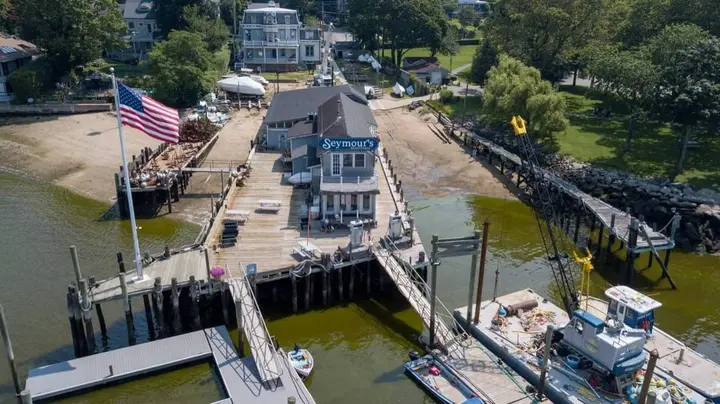Heavy rains down Main Street cause curious green color in Northport Harbor

If you strolled down to the harbor after the heavy rainstorm two weeks ago, you may have noticed that the water took on a strange shade of green. The color is a good indicator of the changes that are occurring within our waterways, which are due, in large part, to human activity and significant runoff down Main Street in Northport Village.
According to Dr. Rebecca Grella, a Northport resident and research scientist who specializes in ecology and evolutionary biology, the green we witnessed after the storm was the result of an algal bloom among the Euglena species that are found in fresh and salt waters.
There are several microalgae species that are native to Long Island and bloom annually. The chloroplasts (remember that term from biology class?) are plant cell organelles that allow for photosynthesis, where the green pigment chlorophyll captures energy from the sun. “When an alga blooms in such high biomass, you can see their color, hence the green,” Rebecca explained.
These blooms are caused by an increase of nutrients and fresh water in our harbor. A significant amount of rain not only provides the fresh water, but causes an increase in nitrogen from runoff, which contains fertilizers and cesspool leaching, and algae thrives in this high-nitrogen environment.
“We are uncertain if toxins were produced in this bloom,” Rebecca noted. “We are currently conducting an experiment, as some species secrete alkaloids that are known to be toxic to fish, but more studies are needed.”
But there are blooms that are detrimental to fish and other aquatic species because oxygen in the water is depleted, causing fish to die. The Alaska bloom is one example of that, and Rebecca explained that the more nitrogen we put in the water, from fertilizers and septic leaching, the more blooms like Alaska we’ll have in our bay.
“Additionally, increased nitrogen is also harmful to our salt marsh grasses. When exposed to high levels of nitrogen, salt marsh plant roots weaken and result in marsh collapse,” Rebecca said. She explained that we have both salt marshes and septic systems all around Northport, so we need to be aware of what we are putting down our drains and on our lawns.
So,what can you do to decrease problematic nutrients in our waters and prevent toxic blooms? Rebecca said to start by curbing your usage of herbicides and pesticides. “Go native and participate in native garden initiatives. Most importantly, check your septic system and remember that all drains lead to the ocean, unless you are connected to a sewer.”
Northport Village also debuted its FLUPSY program last week, which uses oyster seeds to filter water and reduce nitrogen levels. This program, in combination with efforts to reduce our impact on the environment as a community, can have a lasting impact on the health of our harbor and the species living within it.

Northport Harbor on July 17, after heavy rainfall. Photo courtesy of Rebecca Grella.
Don’t miss a story
Get the latest news delivered to your inbox.








